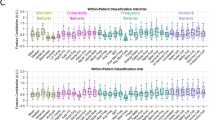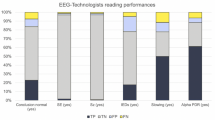An algorithm was proposed for highly specific EEG patterns in neurooncological patients. The algorithm involves selection of reference cases and subsequent classification of these into study and control groups using a database of patients, EEG recordings, and indicators, querying the database, generating singleindicator candidate EEG patterns, using a four-cell table to extract and verify EEG patterns of adequate sensitivity and specificity, and selecting the best. Application of the algorithmic method to material from 368 patients with tumors of basal-diencephalic localization identified new EEG patterns in patients with different anatomical-topographical variants of neuroepithelial tumors of the third ventricle. These patterns can be used to improve the diagnosis and identify the pathophysiological bases of clinical syndromes.
Similar content being viewed by others
References
A. A. Barsegyan, M. S. Kupriyanov,V. V. Stepanov, and I. I. Kholod, Methods and Models for Data Analysis: OLAP and Data Mining [in Russian], BKhV-Peterburg, St. Petersburg (2004).
G. N. Boldyreva, Brain Electrical Activity in Humans with Lesions to the Diencephalic and Limbic Structures [in Russian], Nauka, Moscow (2000).
V. V. Vlasov, Epidemiology: A Textbook [in Russian], Geotar-Media, Moscow (2004), second edition.
I. A. Voronina and V. G. Voronov, A Syndrome Builder Based on Associative Rules, State Computer Program Registration Certificate No. 2008615256, October 31, 2008.
I. A. Voronina and V. G. Voronov, A Diagnostic Test Builder, State Computer Program Registration Certificate No. 2010612012, August 16, 2010.
O. M. Grindel, N. N. Bragina, I. A. Voronina, et al., “Electroencephalographic correlates of impairments to higher cortical functions in local lesions of the hypothalamic area,” Zh. Vyssh. Nerv. Deyat., 45, No. 6, 1101–1111 (1995).
T. Grinkhalkh, Evidence-Based Medicine [in Russian], I. N. Denisov (ed.), Geotar-Media, MX (2008), 3rd edition.
N. N. Danilova, Psychophysiology [in Russian], Aspent Press, Moscow (2000).
I. S. Dobronravova, Reorganization of Human Brain Electrical Activity on Loss and Recovery of Consciousness (cerebral coma) [in Russian], Author’s Abstract of Doctoral Thesis in Biological Sciences, Moscow State University, Moscow (1996).
L. A. Zhavoronkova, Right Handed, Left Handed. Interhemispheric Asymmetry of Human Brain Electrical Activity [in Russian], Moscow (2006).
E. A. Zhirmunskaya and V. S. Losev, Electroencephalography in Clinical Practice. Methods [in Russian], Moscow (1997).
L. R. Zenkov, Clinical Electroencephalography with Elements of Epileptology [in Russian], MEDpress-inform, Moscow (2004).
A. N. Konovalova, A. A. Potapov, V. A. Loshakov, et al., Standards, Recommendations, and Options in the Treatment of Glial Brain Tumors in Adults. Conclusions of the XVIII Plenum of the Directorate of the Association of Neurosurgeons [in Russian], Moscow (2005).
M. N. Livanov, Spatial Organization of Cerebral Processes [in Russian], Nauka, Moscow (1972).
G. A. Shchekutiev (ed.), Neurophysiological Studies in Clinical Medicine [in Russian], Moscow (2001), pp. 50–60.
V. E. Olyushin, “Glial brain tumors: a brief review of the literature and treatment protocols for patients,” Neirokhirurgiya, No. 4, 41–47 (2005).
N. E. Sviderskaya and T. A. Korolkova, “Spatial organization of brain electrical processes: problems and solutions,” Zh. Vyssh. Nerv. Deyat., 47, No. 5, 792–811 (1997).
I. A. Skvortsov, “The role of the periventricular areas in the genesis of abnormalities of neurological development,” Zh. Nevrol. Psikhiatr., 101, No. 2, 50–56 (2001).
R. Fletcher, S. Fletcher, and E. Wagner, Clinical Epidemiology. Evidence-Based Medicine [Russian translation], Media Sfera (1998).
I. A. Chubukov, Data Mining: A Textbook, Internet Information Technology University, BINOM, Laboratoriya Znanii (2006).
E. V. Sharova, Adaptive-Compensatory Rearrangements of Human Brain Bioelectrical Activity in Lesions to Stem Structures [in Russian], Author’s Abstract of Doctoral Thesis in Biological Sciences, Institute of Higher Nervous Activity and Neurophysiology, Russian Academy of Sciences, Moscow (1999).
V. V. Shulgovskii, Physiology of the Central Nervous System [in Russian], Moscow State University Press (1997).
E. B. Broomfield and W. L. Jong, EEG in Brain Tumors (2009), http://emedicine.medscape.com/article/1137982-over-view.
K. Hamandi, A. Salek-Haddadi, H. Laufs, et al., “EEG-fMRI of idiopathic and secondarily generalized epilepsies,” Neuroimage, 31, No. 4, 1700–1710 (2006).
H. H. Jasper, “Diffuse projection systems: the integrative action of the thalamic reticular system,” EEG Clin. Neurophysiol., 1, 405–419 (1949).
D. Le Gars, J. Lejeune, and C. Desenclos, “Tumors of the third ventricle: review of the literature,” Neurochirurgie, 46, No. 3, 296–319 (2000).
A. J. Leal, A. Moreira, C. Robalo, and C. Ribeiro, “Different electroclinical manifestations of the epilepsy associated with hamartomas connecting to the middle or posterior hypothalamus,” Epilepsia, 44, No. 9, 1191–1195 (2003).
S. Pathy, S. Jayalakshmi, S. Chander, et al., “Prognostic factors influencing the outcome of thalamic glioma,” Neurol. India, 50, No. 1, 37–40 (2002).
G. Pfurtscheller, “Event-related synchronization (ERS): An electrophysiological correlate of cortical areas at rest,” EEG Clin. Neurophysiol., 83, 62–69 (1992).
F. Siddiqui, E. Bromfield, and N. Winslow, “Role of EEG in predicting post-operative seizures in brain tumor patients,” Epilepsia, 41, Suppl. 7, 206–216 (2000).
Author information
Authors and Affiliations
Corresponding author
Additional information
Translated from Zhurnal Vysshei Nervnoi Deyatel’nosti imeni I. P. Pavlova, Vol. 62, No. 1, pp. 56–64, January–February, 2012.
Rights and permissions
About this article
Cite this article
Voronina, I.A., Voronov, V.G. & Shchekutiev, G.A. Identification of Highly Specific Electroencephalographic Patterns in Patients with Neuroepithelial Tumors of the Third Ventricle Using Algorithmic Methods. Neurosci Behav Physi 43, 308–314 (2013). https://doi.org/10.1007/s11055-013-9732-1
Received:
Accepted:
Published:
Issue Date:
DOI: https://doi.org/10.1007/s11055-013-9732-1




